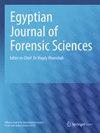Anthropogenetic study of the Arabic - speaking population of Chaouia Ouardigha (Morocco) based on autosomal STRs
IF 1.3
Q3 MEDICINE, LEGAL
引用次数: 0
Abstract
The Chaouia - Ouradigha is a historical and ethno-geographic region of Morocco. Despite its historical relevance, this region has not received sufficient attention in terms of population genetic exploration. The present study aims to provide new data on the genetic background of the Chaouia-Ouardigha population, the Arabic-speaking North African population in the western center of Morocco, and to examine the relationship between this population and other reference populations based on our dataset as well as previously published population data. Genetic exploration will enable the reconstruction of past gene flows that have influenced the genetic makeup of this particular population. We utilized the Investigator® IDplex Plus PCR amplification kit (Qiagen, Germany) to establish the allelic frequencies and forensic statistical parameters of 15 autosomal Short Tandem Repeats (STRs) included in the kit in 153 random healthy unrelated individuals from the Chaouia-Ourdigha region. The Chaouia-Ouardigha population, which speaks Arabic, exhibits a high degree of genetic diversity with heterozygosity values ranging from 0.670 to 0.879. The loci with the highest allele frequencies, namely D7S820 and TPOX, have the lowest heterozygosity values (0.670 and 0.672, respectively), resulting in lower exclusion power (PE) and typical relatedness index (TPI) values (PE = 0.427 and TPI = 1.66 for TPOX; PE = 0.442 and TPI = 1.72 for D7S820). Phylogenetic analysis showed that the Arabic-speaking population of Chaouia-Ouardigha was found to be distinct from Sub-Saharan, East Asian, and Latin American populations. Our study provides insights into the genetic connections of the Chaouia Ouardigha population, highlighting how historical events, socio-cultural influences, and geographical proximity have contributed to shaping their genetic structure. It demonstrates the substantial impact of historical events and geographical closeness in fostering affinities between the Chaouia Ouardigha community and neighboring populations in North Africa, Southern Europe, and the Middle East. Additionally, the study has generated valuable data confirming the effectiveness of these 15 genetic markers for forensic applications across the broader population.基于常染色体 STR 的沙维雅瓦拉迪格阿拉伯语人口(摩洛哥)人类遗传学研究
沙维雅-乌拉迪加是摩洛哥的一个历史和民族地理区域。尽管该地区具有重要的历史意义,但在人口遗传探索方面却没有得到足够的重视。本研究旨在提供有关摩洛哥中西部讲阿拉伯语的北非人群沙维雅-乌拉迪格哈人群遗传背景的新数据,并根据我们的数据集和以前公布的人群数据研究该人群与其他参考人群之间的关系。基因探索将有助于重建过去影响这一特定人群基因构成的基因流动。我们使用 Investigator® IDplex Plus PCR 扩增试剂盒(Qiagen,德国),对来自沙维雅-乌尔迪格哈地区的 153 名随机健康非亲属个体,确定了试剂盒中 15 个常染色体短串联重复序列(STR)的等位基因频率和法医统计参数。沙维雅-乌尔迪格哈人口讲阿拉伯语,具有高度的遗传多样性,杂合度值从 0.670 到 0.879 不等。等位基因频率最高的位点,即 D7S820 和 TPOX,其杂合度值最低(分别为 0.670 和 0.672),导致排斥力(PE)和典型亲缘关系指数(TPI)值较低(TPOX 的 PE = 0.427 和 TPI = 1.66;D7S820 的 PE = 0.442 和 TPI = 1.72)。系统发育分析表明,沙维雅-瓦拉迪格的阿拉伯语人群与撒哈拉以南、东亚和拉丁美洲人群截然不同。我们的研究深入揭示了沙维雅-瓦拉迪格人口的遗传联系,突出了历史事件、社会文化影响和地理邻近性是如何塑造其遗传结构的。研究表明,历史事件和地理位置的接近对促进沙维雅-瓦拉迪格哈族群与北非、南欧和中东邻近族群之间的亲缘关系产生了重大影响。此外,这项研究还产生了宝贵的数据,证实了这 15 个遗传标记在更广泛的人口法医应用中的有效性。
本文章由计算机程序翻译,如有差异,请以英文原文为准。
求助全文
约1分钟内获得全文
求助全文
来源期刊

Egyptian journal of forensic sciences
MEDICINE, LEGAL-
CiteScore
2.00
自引率
0.00%
发文量
51
审稿时长
17 weeks
期刊介绍:
Egyptian Journal of Forensic Sciences, the official publication of The International Association of Law and Forensic Sciences (IALFS), is an open access journal that publishes articles in the forensic sciences, pathology and clinical forensic medicine and its related specialities. The journal carries classic reviews, case studies, original research, hypotheses and learning points, offering critical analysis and scientific appraisal.
 求助内容:
求助内容: 应助结果提醒方式:
应助结果提醒方式:


